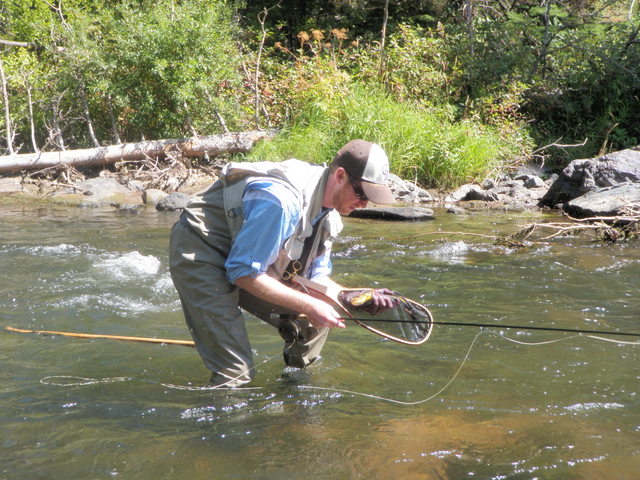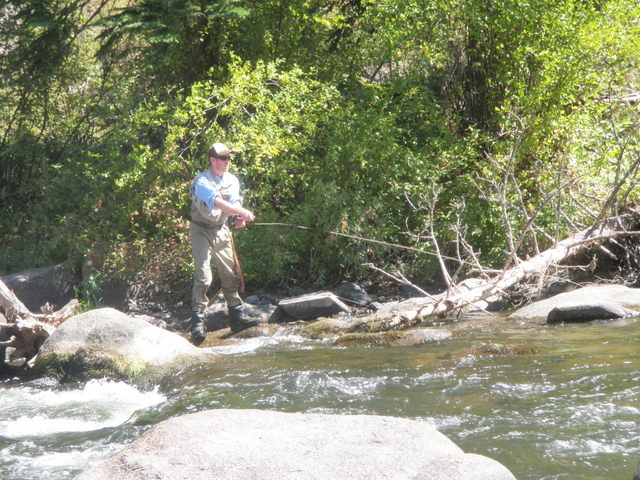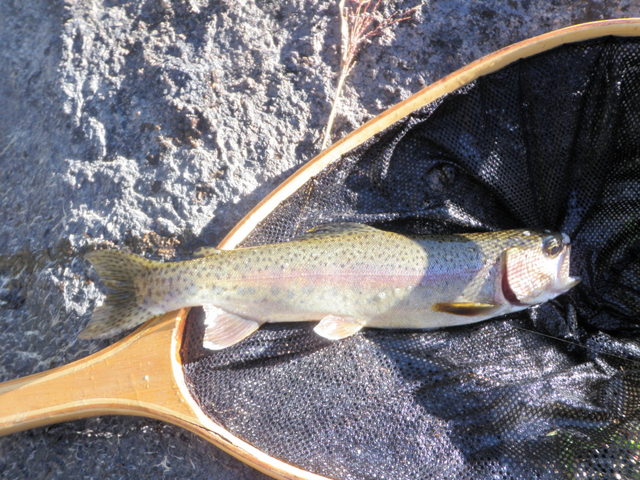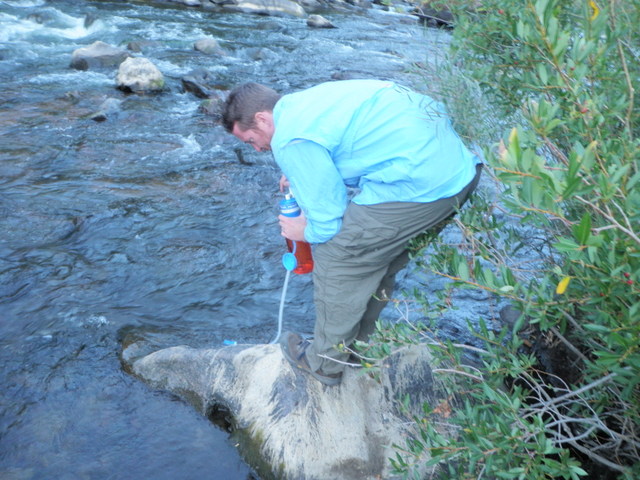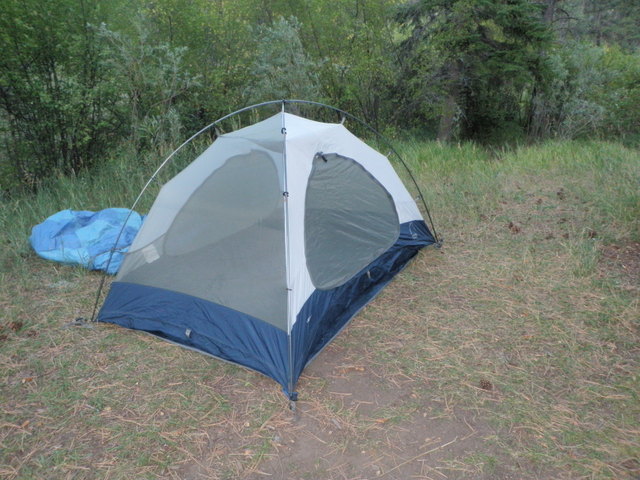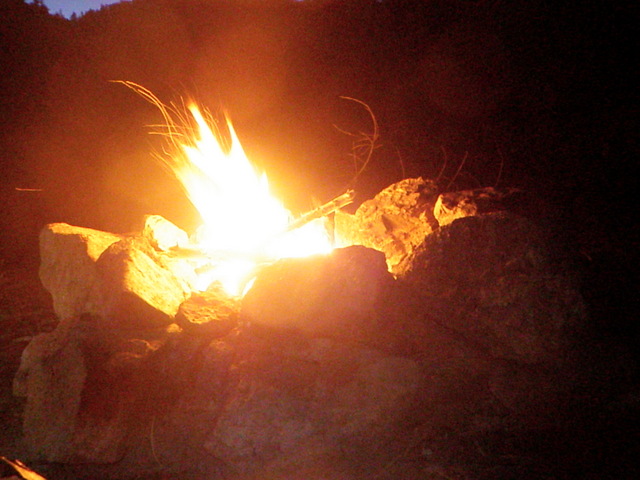Time: 1:30PM – 6:00PM
Location: Wildcat Canyon from just above cascade and narrow canyon to 50 yards below our base camp
Fish Landed: Dave 18; Dan 8
South Platte River 09/08/2012 Photo Album
In 2008 and 2009 Dan and I backpacked into Wildcat Canyon in September of each year and had a great time. A three mile hike is required, and as a novice aging backpacker this is about right for me. After this relatively mild exertion, a beautiful world is pretty much exclusively available to the camper with the cold South Platte River in close proximity. The river valley is fairly wide for most of the stretch available for camping with nice flat areas and the large ponderosa pines are spread out with soft pine needles covering much of the ground. Several well used camp sites are obvious with crude rock fire pits already constructed.
I hiked in to this area in late August and experienced a fabulous day of fishing and of course when Dan heard this tale, he wanted to make the trip again. The only problem was when? Initially Dan was scheduled to go on another weekend camping trip with another couple, but that fell through at the last minute, so we jumped on the opportunity to do Wildcat Canyon on September 8 and 9. Dan met me at our house at 7:30 on Saturday morning and we transferred all his gear to my car and rechecked our lists of necessities. We were on our way by 8AM and stopped in Woodland Park for some last minute food items. Once again we were on our way and reached the trailhead by around 11:30. It took us a bit of time to finalize our packs and attach fishing gear to the outside of our backpacks, and we were probably on the trail by noon. Because my wading boots and waders consume much space in my pack, I elected to hike the three miles in my waders. It turned out to be warm but tolerable.
Once we hit the river we continued on the trail to the place where a fire ring and a log bench are right next to a beautiful pool on the river. We’ve used this on previous trips to stash our gear and set up for fishing. We ate our lunches and then prepared our rods and hiked down the path to a point just above the falls where the canyon narrows between some vertical rock walls. Dan waded to the far side of the river and I took the near bank and we began fishing at around 1:30PM. The flows were 82 cfs, and that was 50% of the level when I fished earlier in August. Because it was a bright sunny day and we were beginning at 1:30 in the afternoon and the flows were down, I didn’t expect much from the river.
I began with a parachute hopper with a hares ear body and a beadhead hares ear nymph and was immediately surprised with a decent brown on the first cast. Just as on my previous trip the brown attacked the nymph late in the drift. Dan was still tying on his flies as I landed another brown on the fourth cast and then a rainbow and another brown. Within the first half hour I had landed five trout, and I was beginning to think this would be a repeat of my earlier stellar trip. Meanwhile Dan finally got his flies in place and began landing fish quickly as well. By the time I landed number five he was at three or four.
Unfortunately after the first half hour the catch rate dropped off significantly. I began seeing some tiny mayflies lifting off the surface of the water, and as this happened the fishing went from ridiculously easy to requiring more casts and covering more water. By three o’clock I’d landed nine trout with a few in the thirteen inch range, but on average they were smaller than my earlier trip. After a half hour of seeing the small mayflies I added a RS2 below the beadhead hares ear as a third fly. The RS2 didn’t really produce any fish, but it did increase the number tangles I had to undo.
Meanwhile Dan picked up a few more trout and several appeared to be decent sized browns. Unfortunately there were a series of downed dead evergreen trees covering half the width of the stream on his side of the river. Dan could spot fish behind the natural structure, but he was also casting a bit long and creating his own messy tangles. Dan’s knot tying proficiency is not as advanced as mine, and extricating himself from tangles consumed a higher percentage of fishing time.
I totally lost track of the time and it seemed to be getting dark early as the shadows extended across the river. The sun fell behind the mountains by around 4PM and the combination of the shadows and my sunglasses made me think it was approaching darkness. As the fishing slowed at 3:30 in the afternoon I noticed more and more small mayflies slowly fluttering up from the water so I decided to try deep nymphing with a strike indicator. My past experience has taught me that this method of fishing is more effective when fish are tuned into active nymphs than dead drifting a nymph below a large attractor indicator fly.
I crimped a split shot on my line above the last knot, added a strike indicator, used a clinch knot to attach a beadhead hares ear, and then knotted an RS2 below the BHHE as my point fly. This proved to be a strategic plus as I began catching fish on the nymphs. Initially I landed two or three fish in an attractive deep run, and I was concerned that my fishing method would only be effective in this type of water. But I also began catching fish in riffles of moderate depth and even in some fairly shallow areas along the edge. Perhaps half the landed fish snatched the hares ear and the other half grabbed the RS2. I also experienced quite a few long distance releases and several foul hooked fish. I’m always amazed when I make an upstream cast with a split shot to shallow water and I lift the flies almost immediately after entry to make sure the split shot isn’t hung up and a fish grabs the nymph on the lift.
After an hour or so of me catching fish, Dan asked me to rig him up with nymphs. We met in the middle of the river and I set up his indicator and split shot and tied on a hares ear and RS2 from his fly box. Dan picked up two or three fish after going to nymphs, but he definitely favors fishing dries or dry/dropper over nymphing.
By 6 o’clock I thought it was time for bed and the fishing had slowed and I was quite weary after the strenuous hike in the heat so we decided to exit the river and return to the base camp. Dan only transported a water bottle quantity of water from the car, so he immediately filtered some water and filled his camelback. Next he set up the camp stove and started the beans and rice which required 30 minutes of cook time. While dinner cooked we set up Dan’s luxurious two person tent that features foyers on each side and a dangling storage caddy below the ceiling. After our tasty dinner we made a campfire and stayed warm until curling up in our sleeping bags at 9:30. I fell asleep dreaming of the 18 fish I’d landed, with nine coming after my switch to indicator nymph fishing.

